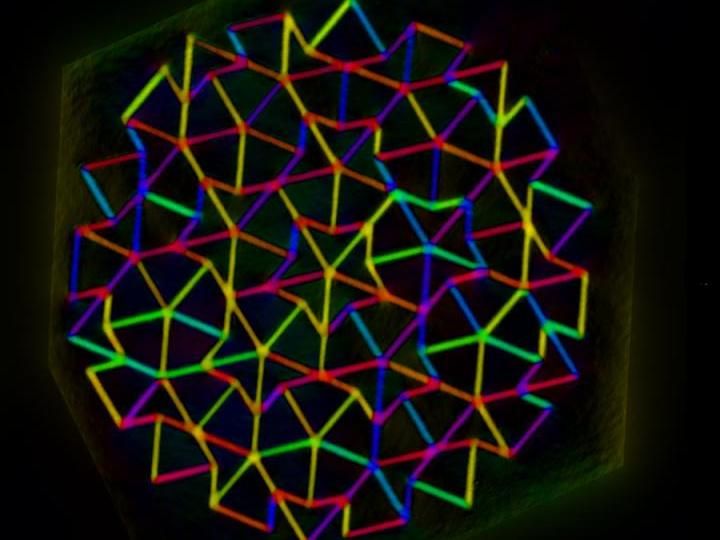Energy cascades in quasicrystals trigger an avalanche of discovery
Most materials, when viewed at the atomic level, come in one of two types. Some materials, like table salt, are highly crystalline, which means that the atoms in the material are arranged in orderly and repeating geometric patterns. Other materials, such as glass, display no such organization; in those cases, the atoms are arranged in what scientists call an amorphous structure.

This image of a quasicrystal lattice shows the unique symmetric but never repeating pattern of its components. The colors correspond to the orientation of the magnetic polarization of each edge.
Amanda Petford-Long/Argonne National Laboratory
A few special materials, however, straddle the line between crystalline and amorphous. These materials, known as quasicrystals, have atomic structures that are geometrically organized but, unlike those of crystalline materials, never repeat themselves. In a new study from the U.S. Department of Energy's (DOE's) Argonne National Laboratory, scientists looked at networks of magnetic material patterned into these unique and quite beautiful geometries to see how the nature of the nonrepeating patterns lead to the emergence of unusual energetic effects.
The simple but elegant geometric patterns within a quasicrystal are reminiscent of a stained-glass window or a Buddhist mandala. "Quasicrystals are scientifically interesting because their internal organization creates effects that you don't see in other materials," said Argonne senior materials scientist Amanda Petford-Long, who led the study.
Just as different pieces of glass come together along their edges to create shapes and patterns in a stained-glass window, a quasicrystal contains junctions that define its behavior. Although the junctions in a quasicrystal where different shapes come together can contain differing numbers of intersecting edges, each junction within a quasicrystal exhibits the same basic physical preference -- to be in the lowest energy state possible. However, because each point within the quasicrystal is constantly interacting and competing with its neighbors, not all of the vertices can be in their lowest energy states at the same time.
In the experiment, the Argonne researchers wanted to see how the quasicrystal's structure responded to adding some extra energy. "We were looking at whether we could actually transfer energy from one side of the lattice to the other, and to image the patterns that emerged when we tried to do so," said Argonne materials scientist Charudatta Phatak, another author of the study.
To their surprise, the researchers discovered that the redistribution of energy through the quasicrystal took place as a chain reaction that resembled the forked branches of a lightning strike. Unlike in a more conventional magnetic lattice, where these "avalanches" of energy redistribution occur only a single direction, the spread of redistributed energy throughout the lattice takes on a tree-like appearance.
Quasicrystals could provide one example of a system that scientists have been looking for: a network made up of magnetic islands that can propagate and store information. The behavior of these kinds of networks depends upon the amount of energy that is put into the system, according to Phatak.
Understanding the energetic behaviors of these kinds of networks is essential for the development of next-generation computational devices that could form the foundation of things like artificial neural networks, which would be able to perform complex computations with very low energy consumption.
Original publication
Other news from the department science

Get the chemical industry in your inbox
By submitting this form you agree that LUMITOS AG will send you the newsletter(s) selected above by email. Your data will not be passed on to third parties. Your data will be stored and processed in accordance with our data protection regulations. LUMITOS may contact you by email for the purpose of advertising or market and opinion surveys. You can revoke your consent at any time without giving reasons to LUMITOS AG, Ernst-Augustin-Str. 2, 12489 Berlin, Germany or by e-mail at revoke@lumitos.com with effect for the future. In addition, each email contains a link to unsubscribe from the corresponding newsletter.

























































